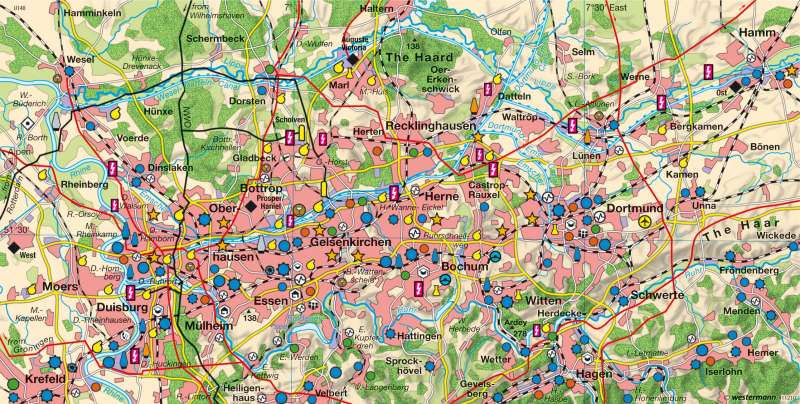The Ruhr today
Europe - Structural economic change
978-3-14-100790-9 | Page 53 | Ill. 5

Information
In 2008 the Ruhr Area is marked by a diverse economic structure, even though the structural problems have not been entirely overcome. New businesses and industries have settled, the infrastructure has expanded (road network, airports, natural gas pipelines from the extraction sites in the North Sea). A process of site consolidation can be seen in almost all sectors of industry. The map shows a concentration of industrial sites in well-developed locations (the "Rheinschiene" along the river Rhine, the Dortmund-Ems canal). Compared to 1960, the area of settlement has increased and the cities have fused together into a dense conglomeration ("Metropole Ruhr").Structural Change
While some 500,000 jobs in manufacturing industry in the Ruhr Area were lost in the last two decades of the 20th century alone, continuous growth has been recorded in the service sector. In the middle of the 1980s, for the first time, more than half of the labour force worked in the field of services, and this proportion has increased steadily: out of today"s employed population of some 2.25 million in the region, 81 percent already work in the tertiary sector and just 18 percent in manufacturing industry. Within the region, Dortmund has the highest share of service sector employees, 88 percent, with just 12 percent still employed in the secondary sector. Although the diversification of industry has progressed, with companies in the electronics and IT sector, large companies such as Thyssen-Krupp, Mannesmann, Bayer (Leverkusen), Ford (Cologne) and Opel (Bochum) have heavily rationalized and in part reduced their workforce. Other large factories, such as the Nokia works in Bochum, have closed completely. On the other hand, small and medium-sized enterprises are expanding.
Since 2000 the Kommunalverband Ruhr (Ruhr association of municipalities) — now the Regionalverband Ruhr, RVR (Ruhr regional association) — has registered the establishment of large numbers of new business in areas such as energy, environment, information and communication technology, medicine, microelectronics, logistics and materials engineering. A decisive aspect of the change from an industrial to a knowledge-based location has been the establishment of technology centres and research institutions. Alongside the universities in Cologne, Düsseldorf and Wuppertal, six new universities have been founded in the Ruhr Area since 1961: Bochum, Dortmund, Essen, Duisburg (which merged in 2003 into the University of Duisburg-Essen), together with the Distance University of Hagen as well as the private University Witten/Herdecke. The Rhine-Ruhr area is thus the most densely-populated university region in Germany.
Culture and Tourism
With its many theatre, music and dance venues, cultural festivals and large numbers of museums, the Rhine-Ruhr area is one of the most significant cultural regions in the world. Much money has also been invested in preserving disused mines and steelworks as industrial monuments or converting them to new uses. Today a total of 52 such monuments to the industrial and cultural past of the Ruhr Area form the "Industrial Heritage Trail". Thus, for example, the "Bochum Jahrhunderthalle", a venue for cultural events of more than regional significance, was created out of the central power station of a steelworks in Bochum, the North Duisburg Landscape Park was developed on the site of the Duisburg-Meiderich ironworks, the old gasometer in Oberhausen serves today as an exhibition hall. The Zollverein coal mine industrial complex in Essen was declared an official UNESCO World Heritage Site in 2002. With the Emscher Landscape Park, the whole region has acquired its own "strip of green". Conversion activities such as these provide a major stimulus for the development of tourism in the region.
E. Michel; Ü: John Attfield




